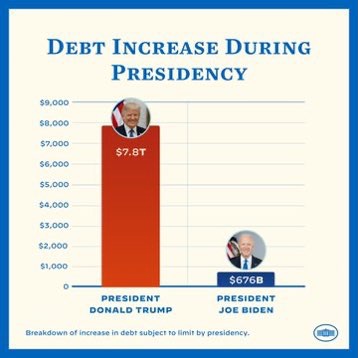
POTUS, The Democrats, and The White House Press Secretary reveal a show and tell chart of our USA Debt Increase comparisons.
The White House is looking to reset the messaging around its multi-trillion dollar spending bills deadlocked in Congress, as President Joe Biden hits the road to pitch popular elements of the package.
The Democrats are also urging lawmakers to pass a bill to raise or suspend the federal government's $28.4 trillion debt ceiling by the end of this week, warning that failure holds devastating economic consequences.
What's the most effective way to determine how much a president has contributed to our nation's massive U.S. debt? The most popular ways to do so involve comparing the debt level from when a president enters the office to the debt level when they leave, and comparing the debt as a percentage of economic output, which takes into account the size of the economy at the time the administration accumulated the debt.
Neither of these techniques mentioned above is a truly accurate way to measure each president's debt because the president doesn't have much control over the debt added during their first year in office.
Having said this, note the previous guy’s spending during Republican control of the Congress and The White House.
The Republicans took office in January 2017. He submitted his first budget in May. It covered the 2018 fiscal year, which didn't begin until October 1, 2017. The GOP operated their first part of his term under President Barack Obama's budget for the fiscal year 2017, which continued until September 30, 2017.
During the 2016 presidential campaign, Republican candidate Donald Trump said he would eliminate the nation’s debt in eight years. Instead, his budget estimates showed that he would actually add at least $8.3 trillion, increasing the U.S. debt to $28.5 trillion by 2025. However, the national debt reached that figure much sooner. When Trump took office in January 2017, the national debt stood at $19.9 trillion. In October 2020, the national debt reached a new high of $27 trillion. That's an increase of almost 36% in less than four years.
At first, it seemed Republicans were lowering the debt. It fell $102 billion in the first six months after they took office. On January 20, the day The former guy was inaugurated, the debt was $19.9 trillion. On July 30, it was $19.8 trillion. But it was not because of anything he did. Instead, it was because of the federal debt ceiling.
The Trump tax cuts made it more attractive for certain company owners to be paid in profits instead of wages. Some cut their own salaries, expanding a loophole that was already costing the U.S. billions. The combined wealth of U.S. billionaires: $3.65 trillion, compared to the estimated annual cost of the Build Back Better Act: $350 billion. America does not suffer from scarcity, but from greed.

